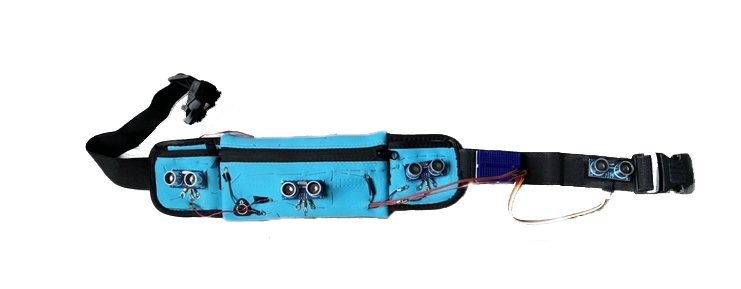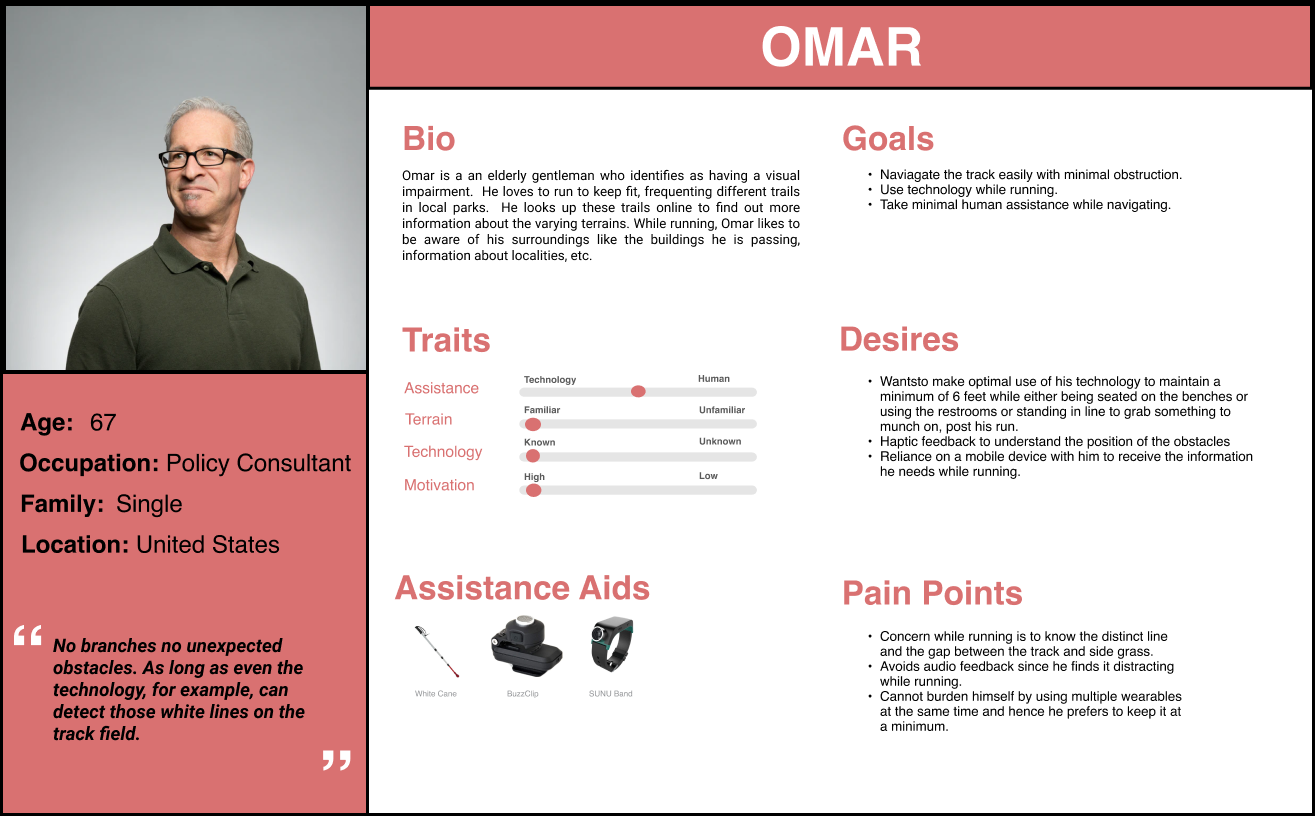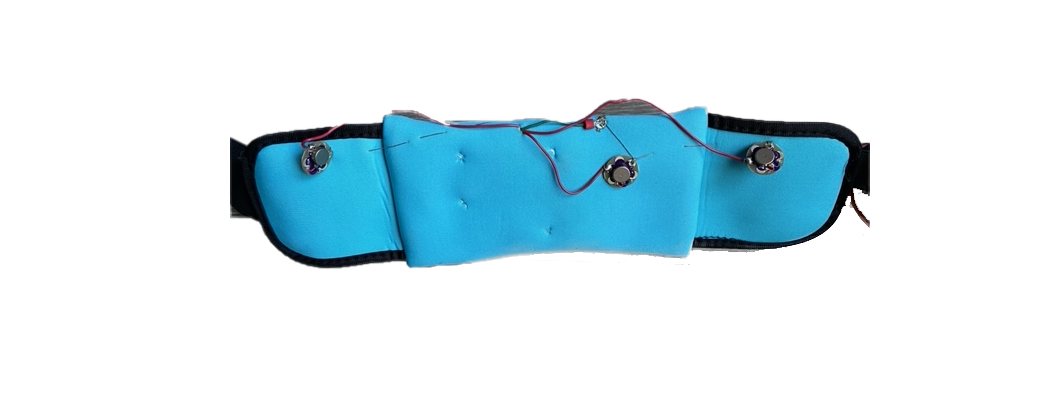TRIDeNT - Navigational aid for runners who are blind
What's this project about?
An industry-funded study to assess how blind users interact with technology while running. The end goal of the study was to develop a prototype that aids them with the detection of obstacles while on the run.
My role in this longitudinal study
This was a two-year project done in collaboration with TOYOTA. It included a team of 5 people, cutting across diversities, including Designers, and HCI Researchers. As the lead user researcher , I successfully helped build the prototype to aid blind runners in leading the team in all UX research related activities.
Outcome of the project
Prioritization of user research and narrowing down on the type of device that can fit the users' needs.
Selection of 3 different sensors (Infrared, Ultrasonic, and LIDAR) to incorporate into the device, and from the research material gathered, Outcome - RUNNING BELT - The TRIDeNT. I determined the features to be developed from interviews conducted with blind joggers and runners.

TRIDeNT stands for Tri-Positional Detection and Navigational Technology. The system's key features include:
- Enhanced awareness of surroundings.
- Detection of obstacles above and below the waist.
- Modes for long and short-range detection.
- Choice of output.
Challenges faced along the way
- A dearth of existing literature about projects and devices used in this space.
- Testing with real users - a problem given pandemic protocols (Eventually maneged to test it on obstacle courses).
- Recruitment of participants was a hard and long process due to the nature of target audience.
- Asynchronous coordination during prototype building extended the time frame of development.
And those are like, tactical buttons, so when you can feel them, push them.
Research Gap with respect to blind runners
- While there is a lot of buzz in the market related to accessibility related products with respect to individuals who are blind, there is hardly any device that pops up specific to running.
- There is not enough documented evidence to suggest existing research aids blind runners.
- Efficiency of many prototypes yet to be tested in real-world setting.
- It is still unknown whether users would be able to connect and run the setup successfully should there be a reassembly or a first time assembly.
- Ease of access and wear of the prototype among prospective users.
UX Research Methods - path to the running belt
To get a solution that would cater to the user's needs, and compelled by the need to plug the research gaps, user research into divided into four phases.
The first phase involved reviews and analysis consisting of:
- Literature Reviews
- Competitive Analysis
- User Interviews
The second phase involved profiling the user base where the team performed:
- Bodystorming
- Storyboards
- Personas
- Affinity Mapping
The third phase consisted of prototype building.
The last phase was the evaluation of the built prototype.
Phase #1 - Review and Analysis
LITERATURE REVIEWS
I populated and read through research papers to gain insight and information on the given topic, identify gaps in previous research related to wearables for blind runners. This rigorous search helped the team to understand the development from other researchers' perspectives. I wanted to have a solid background for our study.
#1. Focus on blind navigation
#2. Multiple ways of feedback presentation.
#3. Multiple Sensor Usage.
#4. Augmenting Experiences.
MARKET ANALYSIS
Then, I looked at different products available on the market. The competitive analysis enabled the team to go through the strengths and weaknesses of the various devices available, used by people who deal with any form of vision impairment. Trying out the devices gave an understanding of the features and functions and informed the design process. User reviews helped the team to understand what the users think about the different products.
Indoors it is fairly useless unless your'e in a high traffic space like an office... or at least one that was designed for high traffic unlike my doctor's office.

USER INTERVIEWS
I ran 1-1 context interviews with individuals with visual impairments and their exercise tendencies and experiences. Through this interview, my team and I further explored the commonly used techniques for running and got feedback on the device idea we were trying to prototype. The blind and visually impaired individuals came with a variety of running experiences ranging from casual hobbits runners to marathon runners and everyone in between.
Participants Interviewed
Demographic: Individuals who are blind and go on runs. They can be first timers, regular marathon runners, or run with a tether. Age: 18+
Gender: Any
Ethnicity: Any
Devices: Mobile (Android and IOS) and others (BuzzClip, SUNU Band, WeWalk Smart Cane, etc.,)
#1. Quality of assistance
#2. Supporting increased autonomy
#3. Support of socialization while running
#4. Addressing uncertainty
It depends on how well you know the trail. I’ve gotten to the point where they just. Give me a really short warning. I’ll be OK because I’m prepping for it anyways. If that makes sense.
Phase #2 - Users
Having understood the competitive landscape, research projects, and the behavior of users while on the run, we were ready to profile the users, build empathy and solidify the information, help in ideating the design for the prototype given the insights we had at our disposal.
PERSONA

Empathy: All the above methods help generate empathy for the users by identifying the type of users who may use the device and their pain points.
Granularity of information: How much information does the user get? Can they learn about unusual obstacles (e.g. construction, tree branches, sudden hurdles)?
Granularity of Feedback: How much feedback is the device going to share? How much impact does the environment have a part in the decision making?
Level of interaction: How much focus does the user need to have on their device? Do they signal it whenever they want information, or is it automatically given to the user?
BODYSTORMING, STORYBOARD AND AFFINITY MAP
I was insistent the team create an affinity map to populate the insights and draw significant themes from the research and profiling. This exercise allowed us to focus on the critical aspects of the study and what users want, giving the prototype building a direction to focus. Parallelly, the team also conducted bodystorming and created storyboards to understand the situational aspects of the device in terms of feasibility and work.

Insights
The team gained valuable actionable insights from the user research conducted.
- Multiple obstacle detection: Array of obstacles to be detected and not just a single obstacle.
- A non-intrusive device that is multimodal: The device should not hinder them in any way either physically or mentally while running
- Presentation of multiple haptic feedback: Receiving an array of feedback in the form of haptics while approaching an obstacle.
- Detection of obstacles: Learning about the obstacle from a short distance away.
- Terrain: The device should work in multiple terrains, and not just track and field.
- Tether: Runners who use the tether, screen the area before the run so that they have a plan and a map in mind.
- Height: While on a trail, the difference in heights can lead to a scenario where the blind runner gets hit by a tree branch while the sighted guide just ducks underneath –
- THE RUNNING BELT - People liked the prospect of a belt to aid them while they are running as they have never tried it before. Although they did not appear to care too much about it, the idea of customization was welcomed.
Phase #3 - Prototype Building
Three different sensors (Infrared, Ultrasonic, and LIDAR) were chosen to be incorporated into the device, and from the research, material gathered, we decided to go with a RUNNING BELT.
The sensors are integrated in a way to mirror what we were working towards – A running belt worn by runners who are blind to detect obstacles.
Velcro is used for ease of use.

We named the device, the TRIDeNT. TRIDeNT stands for Tri-Positional Detection and Navigational Technology.

Impact
- This low cost device consists of a variety of sensors to offer a wider detection range.
- The output works on haptics and can be used by Deaf and Hard of hearing people as well.
- The users do not have to spend money on devices that are expensive and bear only one sensor as this prototype is a handy alternative .
- The team anticipated that people in Low-and Middle income countries would be able to afford the device should it hit the market.
- This device can be used for regular walking as well, extending from the runners .
- This belt is as non-intrusive as possible. Majority of the users feel that the belt is lightweight and can be used as an alternative to the devices currently available.
What we wished to have happened...
We would have liked to have gone one step further and add a camera to detect obstacles on its path and notifying the users - a field where there is a lot of research going on. We would have also liked to test the prototype in different terrains, which was impeaded due to the Global Pandemic - COVID-19.
Takeaways
From start to finish, this project was a learning curve. I realized that empathy generation is key because of the type of audience involved. In addition to that, I also learned to employ the human aspect in research. Without connection and interaction with people, I believe that nothing is possible. Figuring out the research techniques and drawing the right insights is a challenge in itself. Additionally, as we dealt with a niche audience, recruitment for context interviews and observation was also a challenge. Here is hoping that this prototype becomes a product someday. I hope to take this research into the industry where I can work to develop products beneficial for people, one product at a time.